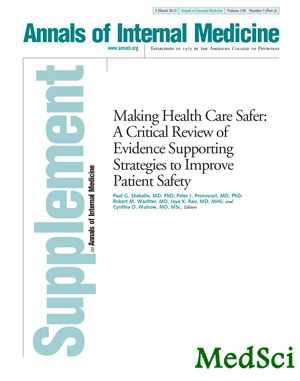ANN INTERN MED:胸腹CT可准确评估腰椎骨密度
2013-04-24 佚名 EGMN
《内科学年鉴》4月16日发表的一项研究显示,因疼痛、胃肠道症状或尿路症状等临床指征进行的腹部和胸部CT扫描通常也会扫描到第一腰椎,因此所获得的扫描图像也可用于评估腰椎骨密度(BMD)和筛查隐匿性骨质疏松(Ann. Intern. Med. 2013:158:588-95)。 这项研究由威斯康辛大学麦迪逊分校放射科的Perry J. Pickhardt博士及其同事进行,纳入10年研究间期内
《内科学年鉴》4月16日发表的一项研究显示,因疼痛、胃肠道症状或尿路症状等临床指征进行的腹部和胸部CT扫描通常也会扫描到第一腰椎,因此所获得的扫描图像也可用于评估腰椎骨密度(BMD)和筛查隐匿性骨质疏松(Ann. Intern. Med. 2013:158:588-95)。
这项研究由威斯康辛大学麦迪逊分校放射科的Perry J. Pickhardt博士及其同事进行,纳入10年研究间期内在6个月内接受CT和双能X线吸收法(DXA)这两种扫描的1,867例成人患者。研究者检索和分析患者的扫描图像,重点研究CT图像上的明显中度或重度压缩畸形,之所以排除轻度压缩畸形是因为轻度病变的判定较为主观,容易产生歧义。
患者共有2,063对CT和DXA评估结果,每次评估之间间隔67天(中位数)。共81%的患者为女性,平均年龄为59岁。患者进行腹部或胸部CT扫描的临床指征主要为疑似肿块或肿瘤学检查(414例)、泌尿生殖系统问题(402例)、胃肠道症状(398例)和/或不明腹部疼痛或症状(374例)。55%的CT扫描使用静脉造影剂。造影剂的使用不影响对扫描所得的腰椎数据的解读。
DXA扫描显示,22.9%的患者有骨质疏松,44.8%存在骨质减少,32.3%的BMD正常。CT扫描区别这3者的敏感性显著高于DXA。具体而言,CT扫描检出119例患者有骨质疏松伴易于识别的中度或重度椎体骨折,而DXA扫描结果显示,在这些患者中,62例患者的BMD正常(12例)或仅存在骨质减少(50例)。
研究者表示,该研究结果与既往研究结果一致,即DXA未检出骨质疏松的许多患者将发生脆性骨折,并表明CT衰减值是更准确的风险预测因子。如果该研究结果被其他研究证实,则所有因任何原因进行的腹部和胸部CT扫描获得的图像也可常规用于腰椎BMD评估。在未来,甚至可能将CT数据整合入骨折风险评估工具中。这将可更早地诊断和治疗骨质疏松并减少昂贵DXA检查的次数,从而可明显节省医疗费用。2011年,美国进行了超过8千万例CT扫描,大部分扫描图像携带有关BMD的有用信息。
与CT相关的拓展阅读:
- J HEPATOL:无黄疸且IL28B CT/TT型AHC患者缺乏HCV清除能力
- Acta Oncologica:分期和治疗差异或导致英大肠癌患者生存率低
- JAMA:高灵敏度cTnT与二级预防的心血管事件相关
- Colorectal Dis:注水结肠镜检查显著降低患者不适
- Epidemiol Infect:HIV患者需加强防范肝炎感染 更多信息请点击:有关CT更多资讯

Abdominal, thoracic CT scans reliably detect incidental low lumbar BMD
Abdominal and thoracic CT scans obtained for a variety of reasons, such as to assess pain, GI symptoms, or urinary tract complaints, also can be used "opportunistically" to examine lumbar bone mineral density and screen for occult osteoporosis, according to a report in the April 16 issue of the Annals of Internal Medicine.
Abdominal and thoracic CT scans done in routine practice happen to include imaging of the L1 level, which can easily be identified because it is the first non–rib-bearing vertebra. Such scans readily yield data on lumbar bone mineral density (BMD), which is a clinically useful way to diagnose or rule out osteoporosis, said Dr. Perry J. Pickhardt of the department of radiology and his associates at the University of Wisconsin, Madison.
It is important not to confuse this standard CT scanning with quantitative CT (QCT) scanning. QCT "is more labor-intensive; requires an imaging phantom or angle-corrected [region-of-interest] measurement of bone, muscle, and fat at multiple levels; and involves additional money, time, and radiation exposure," they explained.
Unlike dual-energy x-ray absorptiometry (DXA) screening or QCT assessment, "the method that we used requires a negligible amount of training and time; could be applied prospectively by the interpreting radiologist or retrospectively by a radiologist or even nonradiologist; adds no cost; and requires no additional patient time, equipment, software, or radiation exposure," the investigators wrote.
Such incidental CT scans can be assessed retrospectively because they are almost always stored indefinitely in electronic medical records, they noted.
Dr. Pickhardt and his colleagues evaluated CT-derived BMD assessment and compared it against DXA scanning of the hips and spine by identifying 1,867 adults who had undergone the two types of scanning within a 6-month period during the 10-year study interval. They retrieved and reviewed the images, paying particular attention to obvious moderate or severe compression deformities on the CT images, rather than to milder ones, "to avoid ambiguity related to more subjective borderline or mild compression deformities."
The study subjects had a total of 2,063 pairs of CT and DXA assessments that had been performed a median of 67 days apart. A total of 81% of these subjects were women, and the mean age was 59 years.
These patients had undergone abdominal or thoracic CT for a variety of clinical indications, most often for a suspected mass or an oncologic work-up (414 subjects), genitourinary problems (402 subjects), gastrointestinal symptoms (398 subjects), and/or unexplained abdominal pain or symptoms (374 subjects).
Approximately 55% of the CT scans involved intravenous contrast. The use of contrast had no effect on the interpretation of lumbar data on the scans.
The DXA screening identified 22.9% of the study subjects as osteoporotic, 44.8% as osteopenic, and 32.3% as having normal BMD. The CT scans were significantly more sensitive than DXA at distinguishing these three states.
In particular, CT scans identified 119 patients as having osteoporosis, with readily identifiable moderate or severe vertebral fractures, when DXA had classified 62 of these patients as having normal BMD (12 subjects) or only osteopenia (50 subjects).
{nextpage}"Our observations are consistent with prior studies documenting that many patients without osteoporosis diagnosed by DXA will sustain fragility fractures, and suggest that CT attenuation may be a more accurate risk predictor," Dr. Pickhardt and his associates wrote (Ann. Intern. Med. 2013:158:588-95).
If their findings are confirmed in other studies, it may become routine for all abdominal and thoracic CT scans performed for any reason to be used for lumbar BMD assessment as well. "In the future, it may even be possible to incorporate CT ... data into fracture risk assessment tools," they added.
This should result in substantial savings in health care costs since osteoporosis will be diagnosed and treated earlier, before fractures occur, and since it also will reduce the number of costly DXA studies performed.
More than 80 million CT scans were performed in the United States in 2011, "most of which carry potentially useful information about BMD," the researchers noted.
The investigators are now turning their attention to using pelvic CT scans that were obtained for various clinical indications to assess hip BMD. "We are currently investigating the potential for deriving a DXA-equivalent T-score for the hips from standard pelvic CT scans by using a dedicated software tool," Dr. Pickhardt and his associates said.
This study was funded by the National Institutes of Health. None of the investigators reported having any financial conflicts of interest.
本网站所有内容来源注明为“梅斯医学”或“MedSci原创”的文字、图片和音视频资料,版权均属于梅斯医学所有。非经授权,任何媒体、网站或个人不得转载,授权转载时须注明来源为“梅斯医学”。其它来源的文章系转载文章,或“梅斯号”自媒体发布的文章,仅系出于传递更多信息之目的,本站仅负责审核内容合规,其内容不代表本站立场,本站不负责内容的准确性和版权。如果存在侵权、或不希望被转载的媒体或个人可与我们联系,我们将立即进行删除处理。
在此留言









#腰椎骨#
32
#腰椎#
25
#Med#
28